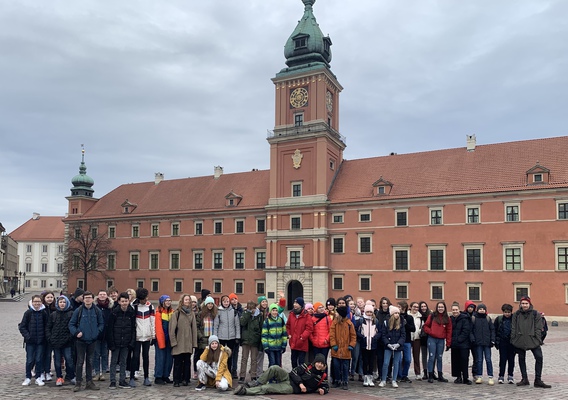Our second international project meeting took place at the Polish partner school Bednarska Szkola Podstawowa - Terytorium Raszynska in Warsaw from the 1st to the 7th of March 2020. This time we dealt with questions regarding architecture and urban planning.

During our meeting in Warsaw the students focused on different urban development approaches and designs, e.g. the socialist realism. Therefore, we visited i.a. the impressive palace of culture, a present to the Polish People’s Republic from the former USSR, in the city centre of Warsaw. This monumental example of architecture with a height of 237m, which was constructed from 1952 to 1955, represented like no other the self-conception of socialist Poland with its numerous -consistently affordable – cultural facilities, restaurants and bars.
Furthermore, based on this concept the Nova Huta district of Cracow was developed, which was also explored by the international group. This district was built after 1949 in close proximity to the also newly built Lenin-steelworks with its temporarily more than 40.000 employees. This part of town did not only provide suitable apartments but was also regarded as a showpiece of socialist city planning with its wide avenues, multiple green areas and numerous theatres, which could be visited free of charge until the 1980s. Additionally, one could also learn a lot about the citizens’ direct influence on politics as the residents of the district wrung a permission of a church construction of the socialist leaders. Thereby, they did not shrink back from a real riot.
Contrarily, the students could observe an entirely different development in the Praga district of Warsaw, which was only slightly destroyed in the Second World War as opposed to the city centre. Nowadays, this district illustrates the contradictory impacts of gentrification. During our visit at the environmental protection agency of Warsaw our team could study another challenge of urban development more closely: at the moment the agency i.a. backfills artificial sand islands into the Vistula in order to restore or rather preserve the original habitat of ground breeders.
Just like during the first meeting in Bad Nenndorf these field trips, in which the students gained various impressions, were followed by workshops with English as the working language. The students were divided into four international groups, in which they had to develop potential solutions for current urban problems using e.g. concrete examples from these excursions. Thus, one group recreated the appearance of a particular street in Warsaw during three different eras at a scale of 1:72. On this basis and with the results of a survey of passersby, other groups formulated proposals for further enhancement of selected districts of Warsaw, e.g. the district surrounding Bednarska Szkola Podstawowa - Terytorium Raszynska. Another working group developed ideas concerning the need-oriented and environmentally sound redesigning of the schoolyard.
On Saturday, at the end of this work-filled week, the exchange students and teachers returned home safely and with numerous new impressions and new friendships. Furthermore, all participants are already looking forward to our next meeting in Champagné in November.